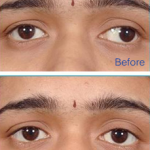What Is Strabismus?
Strabismus, also known as “crossed-eyes” occurs when the two eyes are unable to achieve proper alignment to focus on an object. One eye is generally able to look directly at the object, while the other eye turns in a different direction.
What is Strabismus Surgery?
Strabismus surgery involves loosening or tightening the eye muscles in order to achieve proper alignment of the eyes. This type of surgery is recommended for all types of eye turns, including esotropia, exotropia, hypertropia and hypotropia.
Strabismus surgery is effective 80-90 percent of the time. Some patients, depending on their age and type of strabismus, will require multiple procedures for optimal results.
Will Strabismus surgery give me clear vision?
If you or your child has been diagnosed with strabismus, surgery is an effective way to improve eye alignment. However, it is important to understand that while surgery will correct the eye turn to help your eyes appear aligned, it cannot stimulate the two eyes to work together for clear vision.
Therefore, your eye doctor may recommend a program of vision therapy to improve eye coordination and eye teaming skills— which will also ensure that the eyes remain aligned.
What is a recession procedure?
A recession is used when the muscle is too tight. This procedure involves relocating the muscle to a different area— detaching the affected extraocular muscle from the eye and reattaching it farther back on the eye. By altering its position, the muscle is weakened, leading to improved alignment.
What is resection procedure?
A resection is used when the muscle is too weak to hold the eye in its proper place, and consequently causes the eye to turn. This procedure involves strengthening the extraocular muscle by shortening it, and then reattaching it to its original position.
What is an adjustable suture procedure?
This procedure is performed following a recession or resection procedure in which adjustable sutures were used. During this procedure, the surgeon adjusts the sutures that hold the extraocular muscles in place, and either tightens or loosens them to improve the surgical results and achieve optimal alignment.
This surgery is generally only performed in adults, as the patient remains awake during the procedure with only a local anesthetic. For children with strabismus, a regular suture is typically used.
All sutures will dissolve in about six weeks.

